Introduction
In the realm of electricity distribution companies (DISCOs), a concerning revelation has come to light. According to Senator Mushtaq Ahmed, an alarming amount of free electricity was utilized by power sector employees in 2022, amounting to a staggering Rs. 8.19 billion. This shocking misuse of resources has raised questions about the integrity of the power sector and its impact on the nation’s economy.
The Free Electricity Utilization
The data, sourced from the National Electric Power Regulatory Authority (NEPRA), paints a concerning picture. A staggering 340 million units of free electricity were consumed by power sector employees during the year. Senator Ahmed highlighted these numbers in a recent post on X, emphasizing that around 189,000 employees benefited from this free electricity. This revelation not only points to a gross misuse of resources but also questions the equity and fairness within the power sector.
Economic Implications
The repercussions of this free electricity consumption are substantial. Over the course of the past 15 months, the nation has incurred financial losses amounting to a staggering Rs. 500 billion due to power theft. This financial setback not only impacts the operational capacity of the power sector but also ripples through the national economy. It raises concerns about the allocation of resources and the overall efficiency of the power distribution system.
Accountability and Disciplinary Action
In the wake of these revelations, Senator Ahmed further underscored that a comprehensive crackdown on electricity theft is essential. Highlighting the need for accountability, he revealed that a total of 743 power sector employees were disciplined for their involvement in electricity theft. Such proactive measures indicate a step towards rectifying the power sector’s vulnerabilities and fostering a culture of responsibility.
Distribution of Accountability
Delving deeper, the data reveals that the accountability measures were not uniform across all DISCOs. Among the disciplined employees, 422 were affiliated with the Hyderabad Electric Supply Company (HESCO), 124 with the Multan Electric Power Company (MEPCO), and 118 with the Lahore Electric Supply Company (LESCO). This non-uniform distribution of disciplinary actions raises questions about the internal practices and oversight within these companies.
Quantifying the Free Electricity
A crucial aspect of this issue lies in understanding how much free electricity is provided to power sector employees. According to Senator Ahmed, the allocation varies based on the employees’ grades. Grade 16 officials receive a monthly allocation of 300 free units, while Grade 17 officials are granted 450 units. Moving up the ladder, Grade 18 officials receive 600 units per month. For higher-ranking officers, Grades 19 and 20 enjoy 880 and 1,110 units respectively, while the top tiers, Grades 21 and 22, are entitled to 1,300 free units monthly.
| Grade | Free Electricity Unit |
|---|---|
| Grade 16 | 300 Free Unit |
| Grade 17 | 450 Free Unit |
| Grade 18 | 600 Free Unit |
| Grade 19 | 880 Free Unit |
| Grade 20 | 1110 Free Unit |
| Grade 21 and 22 | 1300 FRee Unit |
Conclusion
The misuse of free electricity within the power sector is a glaring concern that demands immediate attention. The staggering amounts of electricity consumed by employees, coupled with the resultant economic losses, paint a grim picture. Senator Mushtaq Ahmed’s revelations have ignited a discourse on accountability and resource allocation within the power sector, highlighting the need for comprehensive reforms to ensure equity, transparency, and fiscal responsibility. As the nation grapples with the aftermath of this revelation, rectifying the course of action within the power sector stands as a critical priority for a brighter energy future.

